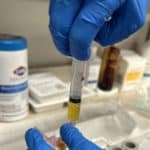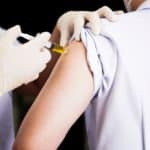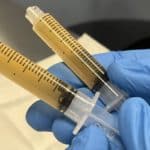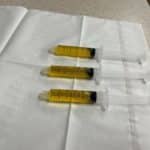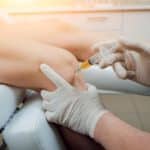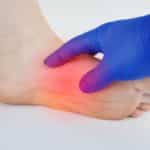Are you tired of the excruciating pain of tennis elbow? Look no further! Platelet Rich Plasma (PRP) Therapy has emerged as an increasingly popular and very promising treatment for addressing tennis elbow pain. Say goodbye to endless discomfort caused by inflammation or damage to your elbow tendons.
In this article, we will uncover the remarkable potential of PRP treatment for providing much-needed relief from the agony of tennis elbow.
Understanding PRP Therapy
Platelet rich plasma injections are the cutting-edge, non-surgical solution you’ve been waiting for. PRP treatment involves drawing some of your blood and spinning it in a centrifuge to separate the platelet rich plasma from other components in the blood, such as red blood cells and white blood cells.
This platelet rich plasma is full of growth factors, which promote healing and tissue regeneration when injected into the affected tendon in your the elbow.
Extensive sports medicine research has demonstrated the effectiveness of PRP in alleviating tennis elbow pain.
In one randomized controlled trial, PRP treated patients displayed lower pain scores and had noticeably improved functionality compared to the control group, making it a great option for those avoiding surgery or long-term medication usage (1).
Causes of Tennis Elbow
One of the most common causes of tennis elbow, also known as Lateral Epicondylitis, is repetitive motion. Overuse and improper technique during activities such as racket sports or manual labor can cause strain on the muscles that attach to the outside of the elbow.
Age can also play a role in developing this injury, as the tissues become less elastic over time.
Poor conditioning and an inadequate warm-up before engaging in physical activity can also contribute to this condition. Additionally, inexperience or poor technique while playing sports can put strains on the tendons and muscles of the elbow, causing irritation and inflammation.
Tennis Elbow Symptoms
Tennis elbow is a common condition that typically causes pain and tenderness on the outer part of the elbow. Other symptoms can also include weakness in the forearm muscles, stiffness in the affected area, and potential numbness or tingling sensations along the arm. It’s important to seek medical attention if you experience any of these symptoms, as early diagnosis and treatment can help reduce
How To Get Diagnosed
The diagnosis of tennis elbow begins with a physical examination by a medical professional, who will assess the affected area for pain and tenderness. Imaging tests, such as X-rays and MRIs may be conducted to rule out other conditions that could be causing similar symptoms.
Additionally, the diagnostic process may involve an electromyography (EMG) test. This specialized nerve conduction test uses electric pulses to assess muscle function and identify any potential nerve damage or blockages that could be contributing to the discomfort.
By combining these three tests, medical professionals can accurately diagnose tennis elbow and recommend the best option for recovery.
Conventional Treatment Options
Conventional treatments for tennis elbow encompass a range of approaches aimed at promoting healing and alleviating symptoms. Initially, resting the affected arm and applying an ice pack can help reduce inflammation and provide relief. Physical therapy can also help recovery as it can help strengthen the muscles around the elbow joint and reduce pain.
Medications, such as nonsteroidal anti-inflammatory drugs (NSAIDs) can also help bring down swelling and alleviate pain. In more severe cases, doctors may recommend a corticosteroid injection (or cortisone injections) to the affected area.
PRP for Tennis Elbow
When it comes to treating tennis elbow, PRP therapy is a revolutionary therapeutic method. Compared to more conventional treatments such as corticosteroid injections, PRP therapy treats the fundamental cause of the issue.
Not only does it harness the body’s natural healing processes, but it also boasts remarkable advantages that set it apart from other approaches. With higher success rates and a lower risk of complications, PRP therapy provides a winning formula for effective and safe treatment (2).
Furthermore, the minimal downtime associated with the procedure allows individuals to swiftly resume their daily activities and regain control of their lives. By choosing PRP therapy, you’re not only opting for a natural healing method, but you’re also maximizing your chances of a successful outcome with minimal risk, making it the unparalleled choice for relief.
What to Expect During PRP Therapy
When undergoing PRP therapy, it’s good to know what to expect so you’re as prepared as possible. PRP therapy is a minimally invasive procedure that can be used to provide relief. The journey begins with a consultation, where a medical professional will discuss your medical history and the severity of your condition.
Next, your blood will be taken, which is then processed in a specialized centrifuge to isolate the growth factors found in platelet rich plasma. Once prepared, the plasma is precisely injected into the affected tendon in your elbow, promoting tissue regeneration and healing.
Following the injection, your doctor will provide guidance for post-treatment care, which may include advice on activities to avoid, pain relief techniques, and any necessary exercises.
Recovery After PRP
After undergoing PRP, a period of post-recovery care and follow-up is crucial for optimal results. Following PRP therapy, pain and discomfort is normal and to be expected. To support the healing process, you should rest for a few days following the procedure to avoid aggravating the joint.
Engaging in targeted physical therapy and rehabilitation exercises under the guidance of a medical professional can further enhance the recovery process, promoting strength, flexibility, and conditioning of the tendon. Regular follow-up visits with your healthcare provider will allow for monitoring progress, addressing any concerns, and making necessary adjustments to your recovery plan.
Platelet Rich Plasma Therapy: A Revolutionary Treatment
Platelet rich plasma (PRP) injections for tennis elbow is a promising therapy option that offers many advantages over conventional treatments, such as steroid injections and surgery. They provide quick relief with minimal side effects, helping patients get back to doing the activities they love more quickly.
With their high success rates and non-surgical nature, PRP is poised to revolutionize the future of tennis elbow treatment, empowering patients to reclaim their active lifestyles.
Q&A:
* Is PRP effective for tennis elbow?
Yes, PRP has been shown to be an effective treatment. Numerous studies and clinical evidence have demonstrated the efficacy of PRP injections in providing relief, improving functionality, and promoting healing for individuals suffering from pain.
* How many PRP injections are needed?
The number of PRP injections needed can vary depending on the individual and the severity of the condition. Typically, a series of one to three injections are administered over a period of several weeks to achieve optimal results.
* How long does it take for PRP to work on tennis elbow?
Patients heal at different rates. While some patients respond quicker to PRP and experience changes in a few weeks, others may require several months to experience full recovery.
* How long does PRP take to heal tendons?
The healing time of PRP therapy to heal tendons can vary depending on several factors, including the specific tendon involved, the severity of the injury, and individual healing abilities. Generally, the healing process can take anywhere between several weeks to a few months, with noticeable improvements typically observed within the first few weeks.


